Основные проблемы теории речевых актов
Translation
Основные проблемы теории речевых актов
Ряд дальнейших проблем возникли в рамках концептуальной модели, созданной кратко описанными выше понятиями, касающимися внутренней организации теории, частично рассматривающую то, как сама теория может способствовать решению некоторых уже существующих проблем языка и речи.
Показатели иллокутивной силы
Иллокутивные акты должны быть понятны слушателям. Поэтому должны существовать способы, с помощью которых ораторы полностью проявляют, или по крайней мере показывают, иллокутивную силу речевых актов.
Традиционно сторонники теории речевых актов придерживаются точки зрения о том, что иллокутивная сила полностью проявляется, когда используется эксплицитная перформативная формула (т. е. перформативный глагол в 1-м лице в настоящем времени изъявительного наклонения активного залога). На основании принятого суждения (ср. Austin, 1962: 61. 71) особое значение приобретают три основных вопроса:
• каким образом воздействуют перформативные высказывания?
• как определить иллокутиную силу речевых актов при отсутствии эксплицитной перформативной формулы?
• каким образом явный и неявный способы совершения одного и того же иллокутивного акта связаны друг с другом?
Ответы на первый вопрос были предложены в литературных источниках, в основном, философских, которые рассматривают реальность существования значения у перформативного высказывания и связь между успешностью и истиной (ср. Warnock 1973; Bach и Harnish 1979: 203-208; Recanati 1981; Leech 1983: 174-I97; Searle 1989).
Что касается второго вопроса, то уже Остин выделил различные типы иллокутивных показателей (1962:73-76). Его список включал наклонение и модальные глаголы, интонацию, наречия, связки (соединительные элементы) и экстралингвистические жесты или контекстуальные особенности, сопровождающие высказывание. Серль подчеркивает роль лингвистических показателей иллокутивной силы и возможность заменять эксплицитные формы имплицитными (ср. 1969: 68). Хотя часто допускают, что главным показателем иллокутивной силы является наклонение (или тип предложения) (ср. Lyons 1977: 745-748), проведение эмпирических лингвистических исследований в области способов совершения различных иллокутиных актов в разных языках делает более понятным более широкий спектр показателей иллокутивной силы. Хотя обычно считается, что в каждом предложении содержится один единственный показатель иллокутивной силы, и что такие показатели не обладают собственным смысловым содержанием, существуют мнения о том, что выражения, имеющие смысловое содержание, также могут выступать в качестве показателей иллокутивной силы (Green 2000) и указание силы может опираться на комбинацию признаков (Sbisa 2001).
Что же касается третьего вопроса, то наиболее известный ответ на него представлен так называемой «перформативной гипотезой», гласящей, что в глубинной структуре любого предложения находится более эксплицитный перформативный глагол (Ross 1970). Эта гипотеза, поддерживаемая в рамках генеративной семантики, была раскритикована и предана забвению (ср. Gazdar 1979:15-35). Последние исследования связана с ранжированием от наиболее эксплицитных до наиболее косвенных способов совершения иллокутивных актов (см., например, Blum-Kulka, House и Kasper 1989:18). в которых перформативная формула не является первостепенной.
Модусы понимания
Понимаются ли иллокутивные силы на основании семантики их языковых показателей или посредством прагматичного умозаключения?
Иллокутивная сила занимает неоднозначное положение между семантикой и прагматикой, она может рассматриваться как чисто семантическое явление, полностью зависящее от кодифицированного смысла слов, вроде бы допуская возможность соотнесения иллокутивной силы с речевыми актами на основании лингвистического показателя (или набора показателей). Однако это не так. Наличие четких показателей в произносимом предложении само по себе не определяет реальности, важности и уместности совершения речевого акта (ср. Davidson 1979). Тогда является ли иллокутивная сила полностью прагматичной? Такое решение предполагало бы минимизацию вклада языковых показателей иллокуции в понимание иллокутивной силы.
Однако такая точка зрения на предложение признавала различные модусы понимания в качестве так называемых прямых и соответственно «косвенные» речевых актов. В то время как прямые речевые акты отображают соответствующие показатели иллокутивной силы, косвенные речевые акты совершаются с помощью произносимых предложений, не содержащих показателей иллокутивной силы, поэтому слушателю приходится понимать эту силу посредством умозаключений (Searle 1 975). Стратегии для совершения и понимания косвенных речевых актов были связаны с явлением вежливости (Brown и Levinson 1987) и с особенностями разных социокультурных сред (Blum-Kulka, House и Kasper Eds. 1989).
Следует отметить, что понятие косвенного речевого акта основывается на теории импликатур Грайса, и поэтому его отвергают все, кто не принимает эту теорию. Косвенные речевые акты могут брать свое начала в некоей условности, сценарии или схеме.
Речевые акты и истинность
В философии традиционно проводят различие между ассертивным (утвердительным) или дескриптивным (описательным) языком, с одной стороны, и всеми видами использования языка, которые не являются ни истинными, ни ложными, с другой стороны. Существует еще одна тенденция в философии и, в частности, в логике, рассматривать предложения, как содержащие значение истинности, совершенно независимо от их фактического произнесения в контексте.
Теория речевых актов предлагает наличие другой точки зрения, согласно которой утверждения есть речевые акты, также, как и приказы, обещания, извинения, предписания, и ни одно предложение по сути не может однозначно являться либо истинным, либо ложным. Вопрос об истинности или ложности может возникнуть только тогда, когда предложение используется при совершении утвердительного (ассертивного) речевого акта. Однако, данная идея имеет свои минусы.
Во-первых, является удачное совершение речевого акта условием истинности/ложности утверждения (как определяют Austin 1962 и Strawson 1950) или это исключительно вопрос целесообразности, в то время как истинность/ложность утверждения самостоятельно основывается на условиях истинности (что соответствует Grice 1975)? Во-вторых, что именно мы называем «истиной/ложью»: весь ассертивный речевой акт, или его локутивный или пропозициональный компонент? Хотя результаты обсуждения этих тем в рамках философии нельзя рассматривать как окончательные и бесповоротные, широко распространенным является мнение о том, что все, что считается истинным или ложным, представляет собой пропозициональный компонент ассертивного речевого акта (Searle 1968; Strawson 1973). Реализуя данную точку зрения, приверженцы контекстуализма подчеркивали, что пропозиция, подлежащая оцениванию, определяется не только произносимым предложением, но и зависит от многих видов информации в рамках ситуационного или когнитивного контекста (см., например, Travis 2000; о критике, Cappelen и Lepore 2005).
Дальнейшая проблема связана с тем, существует ли оценка неассертивных речевых актов, связанных в определенными фактами и, таким образом, параллельно с оценкой истинности/ложности. По мнению Остина, существуют способы, с помощью которых мы соотносим неассертивные речевые акты с фактами в рамках «объективной оценки произнесенного высказывания»; например, совет может быть хорошим или плохим (Austin 1962: 141-42). Серль (1976) решает вопрос по-другому, выделяя два основных «направления приспособления», от мира к словам и от слов к миру: в случае (например) приказа, в котором истинность утверждения заключается в послушании.
Analysis
Speech act theory plays an important role in linguistics. It attempts to explain how speakers use language to accomplish intended actions and how hearers infer intended meaning form what is said. That’s why I have chosen the article under the title “Main problems in speech act theory”.
The academic functional style is known to have certain linguistic markers on each language level. On the morphological level, they are represented by academic suffixes and prefixes. For example, primacy, tendency, semantics, pragmatics, successfulness, politeness, appropriateness, prototypical.
As for the lexical level, there is a great number of terms used in the text. They are, for example, speech act, Illocutionary acts, illocutionary force, performative formula, mood, modal verbs and others. Abundance of proper names proves stylistic affiliation of the text (e.g. Austin, Searle, Vendler, Wunderlich, Bach, Harnish, Sbisa). The next characteristic is the presence of abbreviation (e.g. cf., e.g., i.e.). No phrasal verbs or words with emotive colouring are to be found in this passage. Academic Functional style does not imply the usage of expressive means or stylistic devices. However, links verbs, such as to prove or to involve, are used in the text.
The syntactical level of this text as one of the academic functional style is characterized by complete and extended sentences with various types of clauses. Strong reliance on passive voice can be highlighted as a linguistic feature of the style under consideration. (Illocutionary acts have to be understood by hearers. It has been generally maintained… Answers to the first question have been proposed in the literature… Recent research is concerned with scales…). The text is full of participial, gerundial and infinite constructions. (…that he took to be performatives. … only if it were possible to assign illocutionary forces… the proposal has also been made to admit of different modes… partly concerning the internal organization of the theory, partly regarding how the theory itself… and inexplicit ways of performing the same illocutionary act…)
Impersonal constructions are also among typical features (explicit forms for implicit ones… classification of illocutionary acts has been by far the most influential one).
The textual level has also its stylistic markers, such as descriptive narration with argumentation and interpretation. There are a lot of references throughout the text. Transitional signals are also widely utilized to emphasize the logical character of the text. (Therefore… As to the second question, As to the third question, Though … However,…)
To sum it up, all the linguistic markers on each level prove that the text under consideration belongs to the academic functional style.
I consider the title of the text as a good one, as it attracts each reader’s attention and also tells the reader what the paper is about. This title suggests guidelines and consists of nominal group constructions. According to Harley’s classification the title of the article announces the general subject.
Speaking about the structure of the article, we can mention that it is divided into six parts. The first one is the introduction where the author writes where and when the problems discussed in the chapter appeared. The main part of the text is divided into five subtitles, which indicate the contents of the next few paragraphs. For example: "Illocutionary force-indicating devices" or "Modes of understanding".
There are three key-words in the article: Illocutionary force, speech act, performative utterance. Illocutionary force and performative utterance are the common terms of the article. Speech act is the main object of study. Therefore the choice of keywords is logically determined.
Annotations
1)
Рассматриваемая глава «Основные проблемы в теории речевых актов» посвящена основным спорным вопросам, возникающим при изучении индикаторов иллокутивной силы, классификации иллокутивных актов, выявлении модусов понимания, изучении речевых актов и их правдивости, а также сопоставлении универсальности и лингвистической и культурной относительности речевых актов. Особенностью данной главы является приведение мнений наиболее авторитетных исследователей в области теории речевых актов, что позволяет получить наиболее полное представление о вопросе.
2)
Jef Verschueren, Jan-Ola Östman. Handbook of Pragmatics Highlights (volume 1): Key Notions for Pragmatics. John Benjamins Publishing, 2009. Chapter Speech act theory/ Main problems in speech act theory by Marina Sbisa
The chapter is written by professor of Philosophy Marina Sbisa from the University of Trieste who has made a great contribution to the study of speech act theory. The work is devoted to the disputable moments about illocutionary force-indicating devices, classification of illocutionary acts, modes of understanding, truthfulness of the speech acts and study of Universality and the linguistic and cultural relativity of speech acts. The author does not present any subjunctive view points but refers to the distinguished scientists such as John Ostin, John Rogers Searle, Anna Wierzbicka and others. The work would be useful for students and researchers interested in pragmalinguistics and the main aspects of the speech act theory. Despite a big number of specific terms the work is easy for comprehension
Abstract
Speaking about the problems Marina Sbisa covers the following:
Speech acts and truth
The work compares two different tendencies about presence of truthfulness in sentences and also gives the point of view of the speech act theory, which goes on to say that “assertions are speech acts just as well as orders”. But this assumption can also be disputable.
Presentation
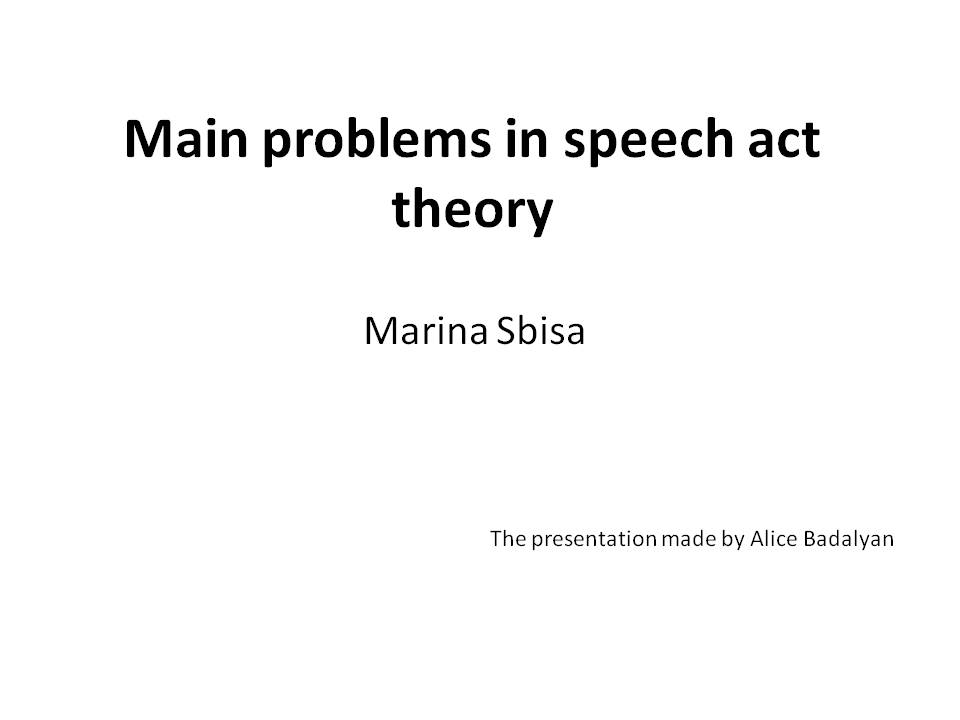
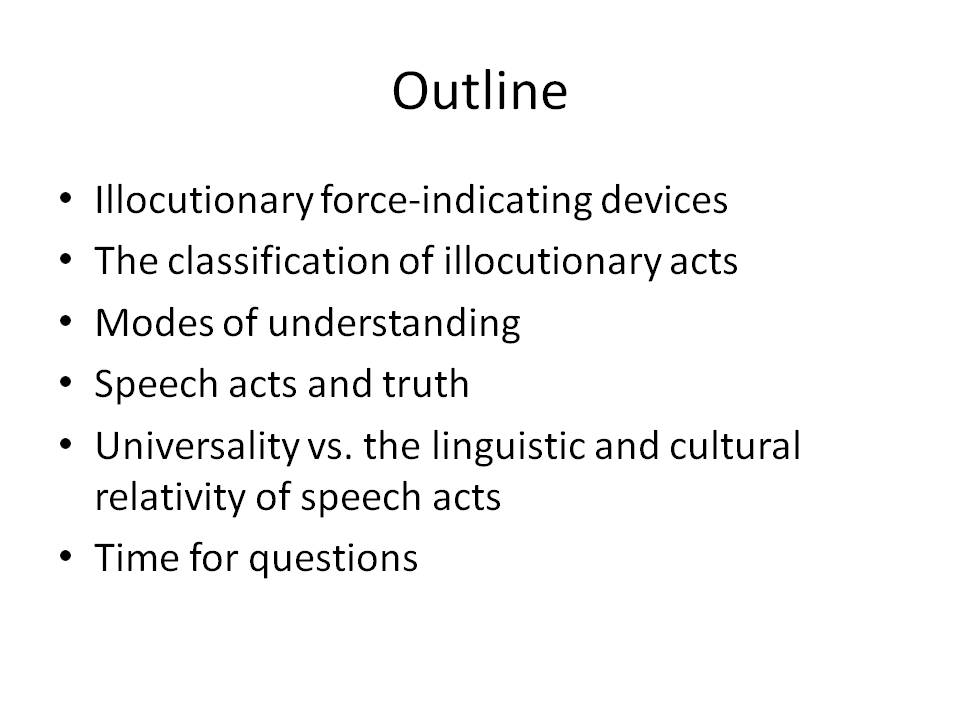

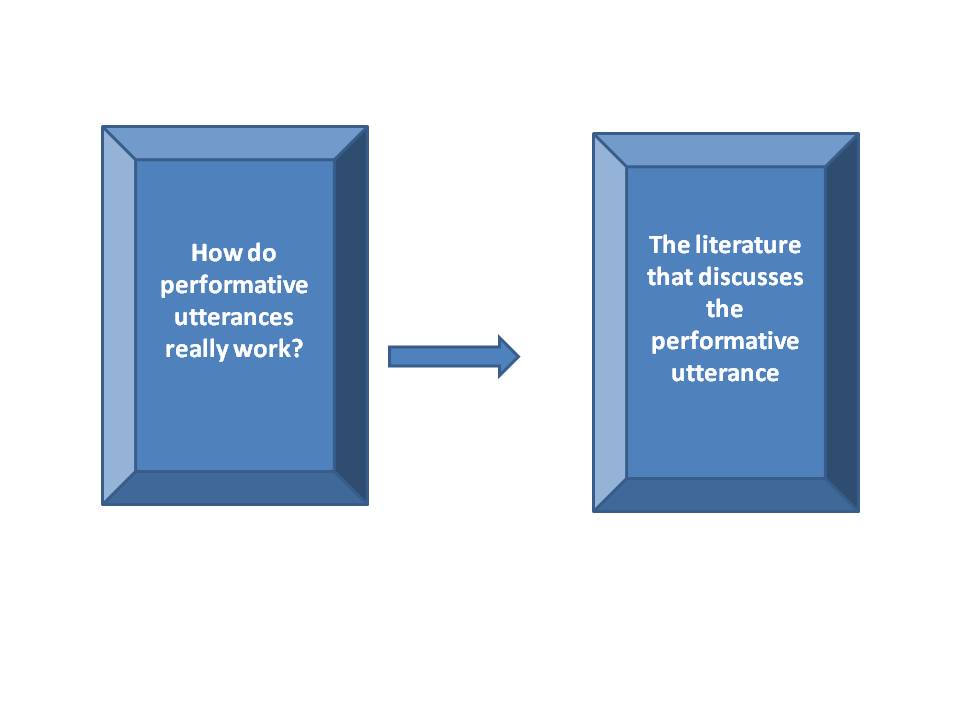
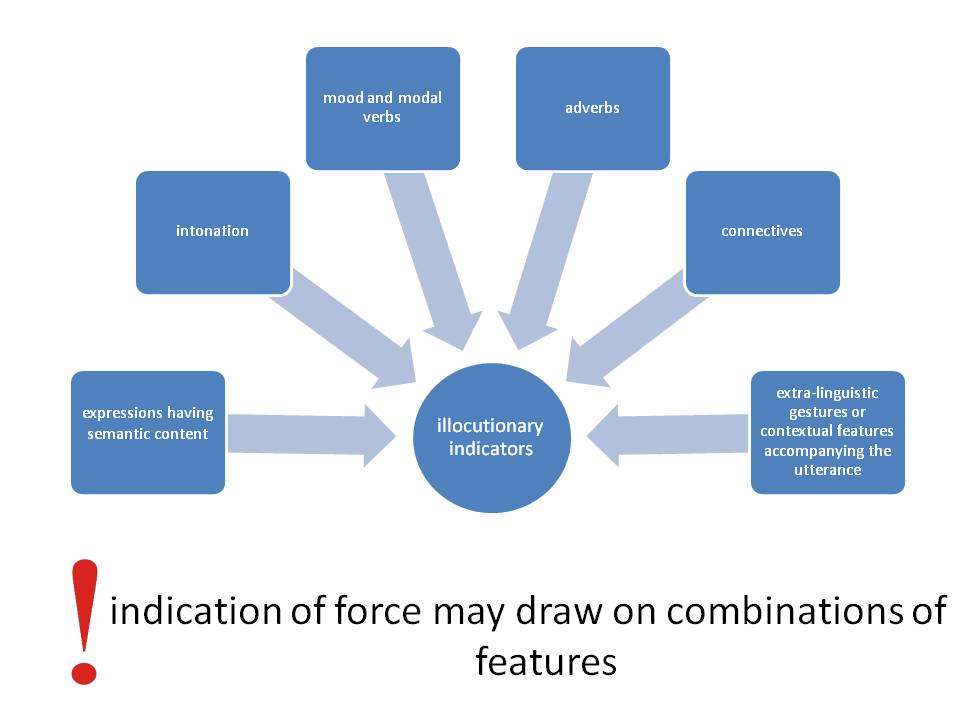

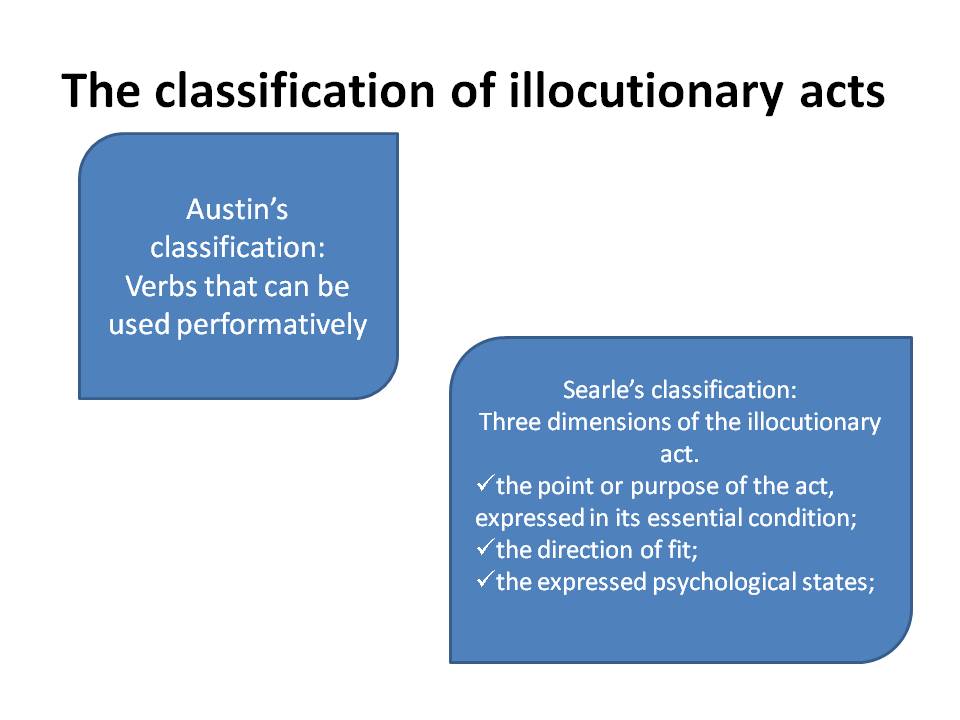
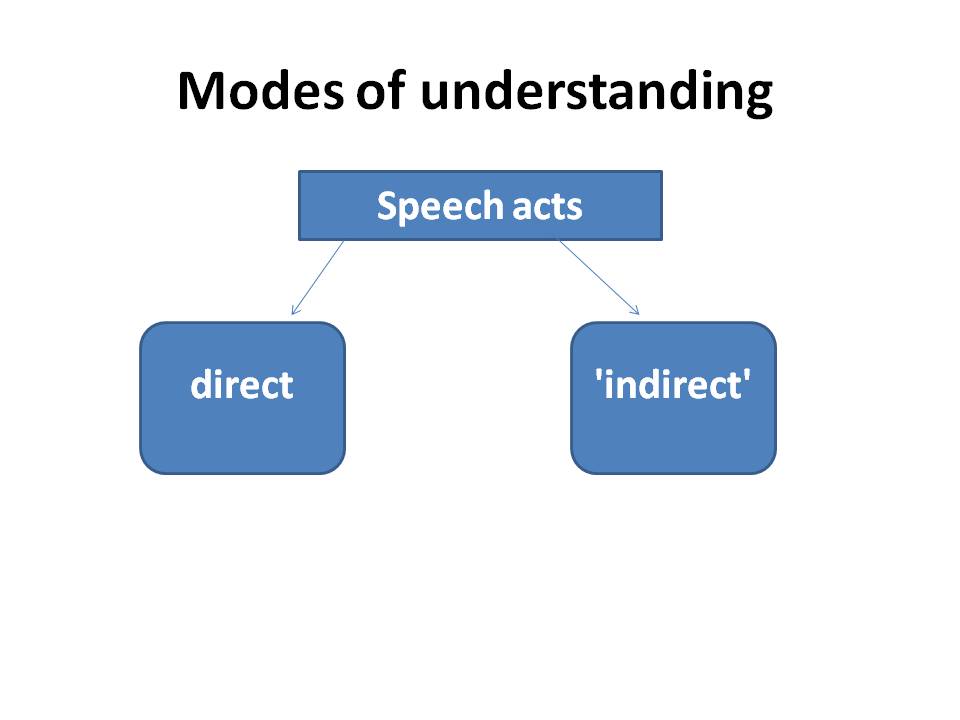
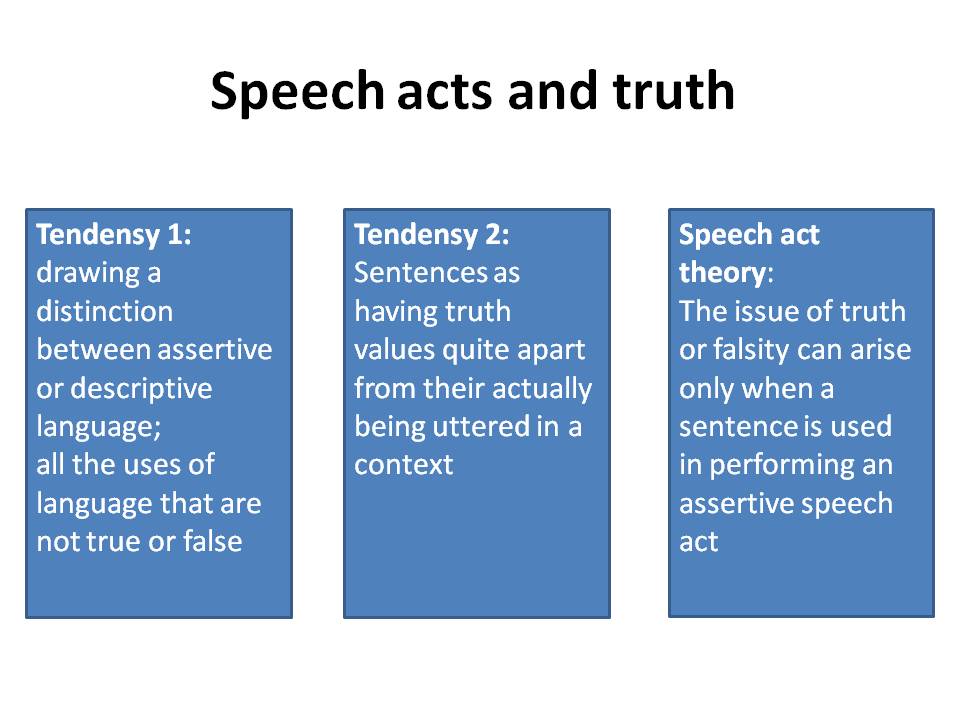
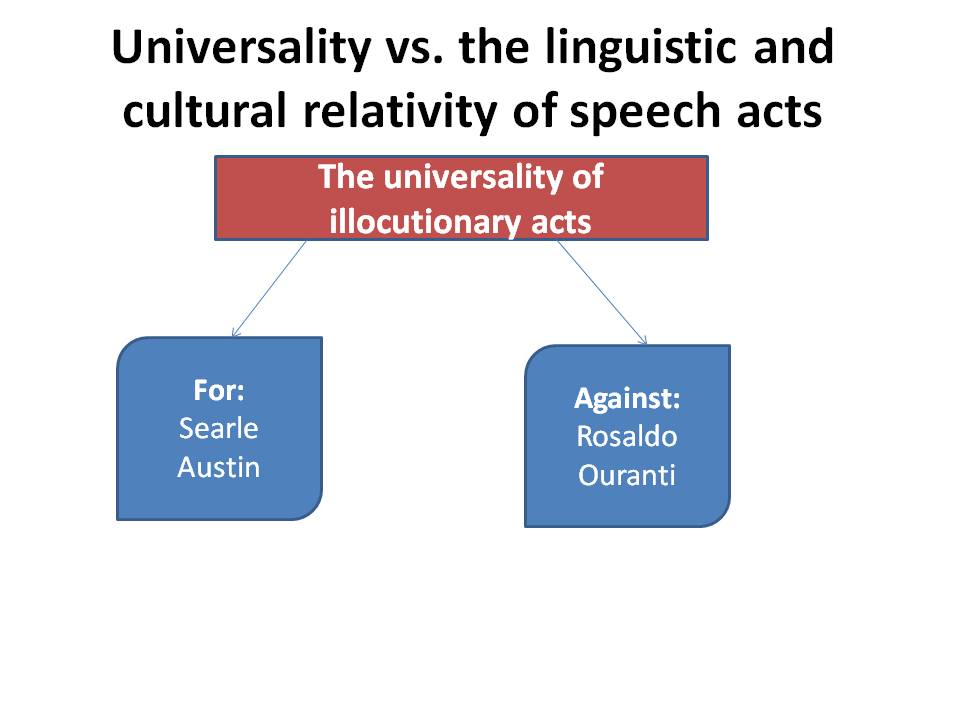

Modes of understanding
Are illocutionary forces understood by virtue of the semantics of their linguistic indicators or by means of pragmatically invited inferences?
Illocutionary force occupies an ambiguous position between semantics and pragmatics, it could be considered as a purely semantic phenomenon, wholly dependent on the codified meaning of words, only if it were possible to assign illocutionary forces to speech acts on the sole basis of the linguistic indicating device (or set of indicating devices). But this is not the case. The presence of clear cut indicators in the uttered sentence does not by itself determine the actual, serious and felicitous performance of the speech act (cf. Davidson 1979). Is then illocutionary force wholly pragmatic? This solution would involve a minimization of the contribution of linguistic illocutionary indicators to the understanding of illocutionary force.
However, the proposal has also been made to admit of different modes of understanding for the so-called direct and respectively 'indirect' speech acts. While direct speech acts display appropriate illocutionary indicators, indirect speech acts are performed in uttering sentences which do not contain indicators of their intended force, so that the hearer has to understand such force by inference (Searle 1 975). Strategies for performing and understanding indirect speech acts have been related to politeness phenomena (Brown & Levinson 1987) and to different socio-cultural environments (Blum-Kulka, House & Kasper Eds. 1989).
It should be noted that the notion of an indirect speech act relies on Grice's theory of implicature and is therefore liable to be rejected by those who do not accept that theory. Indirect speech acts may then be traced back again to some kind of convention, script or schema.
Speech acts and truth
There is a tendency in philosophy to draw a distinction between assertive or descriptive language on the one hand, and all the uses of language that are not true or false on the other. There is another tendency, in philosophy and in particular in logic, to consider sentences as having truth values quite apart from their actually being uttered in a context.
Speech act theory proposes a different perspective, according to which assertions are speech acts just as well as orders. promises, apologies, appointments, and no sentence as such can be said to be either true or false. The issue of truth or falsity can arise only when a sentence is used in performing an assertive speech act. However, this perspective is not without problems.
First of all, is speech act felicity a precondition for the truth/falsity assessment (as Austin 1962 and Strawson 1950 put it) or is it a mere matter of appropriateness, while the truth/falsity assessment independently relies on truth conditions (as Grice 1975 would say)? Secondly, what exactly is it that we are calling true/false: the whole assertive speech act, or a locutionary or propositional component of it? Although the debate about these topics in philosophy cannot be considered as settled once and for all, one widely shared view is that what is deemed true or false is the propositional content of an assertive speech act (Searle 1968; Strawson 1973). Contextualis
t developments of this view have stressed that the proposition to be evaluated is not determined by the sentence uttered alone, but depends on many types of information provided by the situational or the cognitive context (see e.g .Travis 2000; for criticism, Cappelen & Lepore 2005).
A further related problem is whether there are assessments of non-assertive speech acts related to the correspondence to facts and thus parallel to the truth/falsity assessment. According to Austin, there are ways in which we relate non-assertive speech acts to facts in an "objective assessment of the accomplished utterance''; e.g., a piece of advice can be good or bad (Austin 1962: 141-42). Searle (1976) tackled the issue in a different way by distinguishing the two main ''directions of fit', from world to words and from words to world: in the case (for example) of an order, what corresponds to the truth of an assertive is obedience.
Translation
Основные проблемы теории речевых актов
Ряд дальнейших проблем возникли в рамках концептуальной модели, созданной кратко описанными выше понятиями, касающимися внутренней организации теории, частично рассматривающую то, как сама теория может способствовать решению некоторых уже существующих проблем языка и речи.
